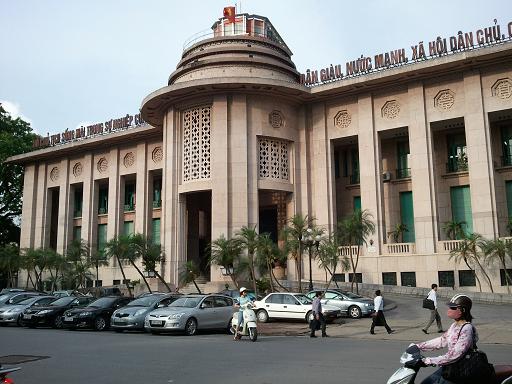 Economy
Economy

The interest rate of seven-day treasury bills was adjusted down to 2.75 per cent per year last week.

|
| SBV headquarters in Hà Nội. The SBV last week also net injected VNĐ19 trillion (US$815.45 million) via treasury bills. — Photo SBV |
HÀ NỘI — The State Bank of Việt Nam (SBV) has reduced interest rates on treasury bills for the first time since March.
According to a weekly report on monetary market of the Saigon Securities Incorporation (SSI), the interest rate of seven-day treasury bills was adjusted down to 2.75 per cent per year last week, down 25 basis points against March.
The SBV last week also net injected VNĐ19 trillion (US$815.45 million) via treasury bills so inter-bank interest rates decreased during the week, currently at 3.08 per cent for overnight term and 3.18 per cent for one week terms, down 10 basis points and 12 basis points, respectively compared to the previous week.
Meanwhile, inter-bank interest rates for US dollar loans continued to be less volatile compared to the previous week. At the end of the week, the overnight interest rate stood at 2.51 per cent (down one basis point); one week 2.59 per cent (unchanged), two weeks 2.66 per cent (down one basis point) and one month 2.78 per cent (down two basis points).
The gap between interest rates in the Vietnamese đồng and the US dollar dropped to 0.6-0.7 per cent per year.
According to SSI analysts, if the US Federal Reserve (Fed) cuts interest rates at the end of July as expected, it will not affect the SBV’s monetary policy too much, but make the implementation of favourable monetary policy directions smoother by reducing pressure from exchange rates.
Looking back from the end of 2015, although the Fed raised interest rates, the SBV’s interest rate and open market operation (OMO) interest rates remained stable. At some times, the OMO interest rates plummeted to below 1 per cent annually. This shows Việt Nam’s monetary policy is quite flexible, with the aim of stabilising the currency and being cautious in regulating cash flow and controlling credit quality.
As the central bank recently raised the credit growth limit for certain banks, some believed it was loosening monetary policy. However, SSI analysts said it was not an expansion of the SBV’s 14 per cent credit growth target set for the entire banking system this year and this was still under the SBV’s orientation from the beginning of the year, based on actual credit growth in the first six months of 2019.
Firstly, the analysts explained, this year’s credit growth target for the entire banking system is 14 per cent but the credit growth limit allocated to each bank was lower at some 11-13 per cent at the beginning of the year, even the rate at some banks such as Vietinbank and Sacombank was only 7 per cent.
Secondly, the central bank expanded the credit growth quota for just eight commercial banks that met Basel II international banking standards earlier than scheduled. So if all eight commercial banks had their credit growth limit raised to the expected level, total increased loans would be some VNĐ46 trillion, accounting for merely 0.6 per cent of total outstanding loans of the whole banking system. — VNS




